|
!!! Every benchmark we do leverages the Scalebench platform, which installs and runs well known benchmark suites and tools in an automated fashion, and processes the results into graphs and reports (as seen below) for analysis. |
AWS is well known for it’s EBS (elastic block storage) offering, which effectively separates (both physically and functionally) the storage component of a VM from the processing component. This means that it’s trivial to mix and match front end processing systems, allowing a user to upgrade/downgrade/pause an instance seamlessly with storage waiting to be re-attached. This storage can be found on separate instances using the AWS custom built nitro system. Multiple copies of data for a given EC2 instance are read/written to within the same availability zone. Based on their details page we are going to assume it’s a one (or more) disk master copy read/write, and there are other disk (set) copies on other servers that are written to asynchronously, and not used for reading (that would be the safest way to do it and avoid getting into the weeds of architecting a synchronous cluster based storage system).
So what is the other option? The old fashioned way of having one or more disks physically attached to your server. AWS does have this, they call it ‘instance store’, and you’ll see on the instances types page, any listing with NVMe SSD, supports local disk. However, beware, for the AWS version of local disk is ‘ephemeral’, which means if the instance is either stopped, or terminated, you lose the data (rebooting is okay). This is likely due to their overall architecture philosophy where once an instance is stopped, the front end processing VM (included any attached disks) is thrown back into the pool for other users. The big advantage local storage has, is the close proximity and thus low latency of interactions, and so they certainly should perform better.
Why don’t they offer a class of servers with local storage AND durable local storage? We’ll just chalk it up to business reasons.
so let’s compare the following options and see how they perform,
-
- EBS SSD general iops (about 3k for a 1TB volume)
- EBS SSD provisioned iops (about 50k for a 1TB volume)
- NVMe SSD local disk (one disk raid 0)
- NVMe SSD local disk (two disks striped raid 1)
* you would generally never run a local disk as raid 0 (otherwise you’d risk losing your data on failure), but it’s useful to how a single disk performs for the active workload and how multiple disks can improve performance.
more details can be found by viewing the report.
Specs are the following,
M5.8xlarge / M5d.8xlarge
-
- 32 cores / 3201.76 mhz / Intel(R) Xeon(R) Platinum 8175M CPU @ 2.50GHz
- L1d: 32 L1i: 32 L2: 1024 L3: 33792
- RAM: 123.16 GB / swap: 0.00 GB / hugepages: 0.00 GB / hp size: 2.00 MB
- (m5d.8xlarge local disk) 2 X 558.80 GB, ext4
- (m5.8xlarge EBS) 1023.00 GB, ext4
- Amazon Linux AMI 2018.03 35.164.220.8
Testing Parameters
We use the Scalebench platform to leverage Sysbench benchmarking tool.
-
- Sysbench benchmark suite
- 3 X 60 second runs (yes, pretty short runs. more on this below)
- disk – seqrd, seqwr, rndrd, rndwr (default settings)
- total file size of 500GB ( >> 128GB memory)
- 16KB requests
- Sysbench benchmark suite
Results
We do 4 separate tests read/write in sequential/random fashion. Before we start to analyze the results, there are a few AWS specific limits to keep in mind, which are detailed here and here. Essentially AWS has both I/O and throughput limits for EBS and specifics depend on the volume type.
-
- EBS 3k – 3,000 iops | 250MB/sec throughput
- EBS 3k – 50,000 iops | ~800MB/sec throughput
- EBS per instance (m5.8xlarge/ m5d.8xlarge) – 30,000 iops | ~850MB/sec*
* and so the instance type can limit the iops and throughput regardless of the EBS storage settings.
Random Writes – Because it’s a random access pattern, each piece of data will likely reside on a different block, and thus generally an I/O per request. So iops becomes the limiting factor. The graph shows this to be quite true for EBS general iops which tops out at about 3,000 iops for 2+ threads. the EBS provisioned iops improves with more threads, however tops out at 32+ threads and begins to degrade due to thread contention. Also the max iops reached was ~ 23k iops, somewhat lower than the instance max of 30k iops. The local disk results both reach max capacity much more quickly at 4+ threads as there is no imposed limit, and due to low latency of local disk. The single disk vs. raid 1 (two copies), have the same results, as raid1 has to write a copy of the data to each disk. 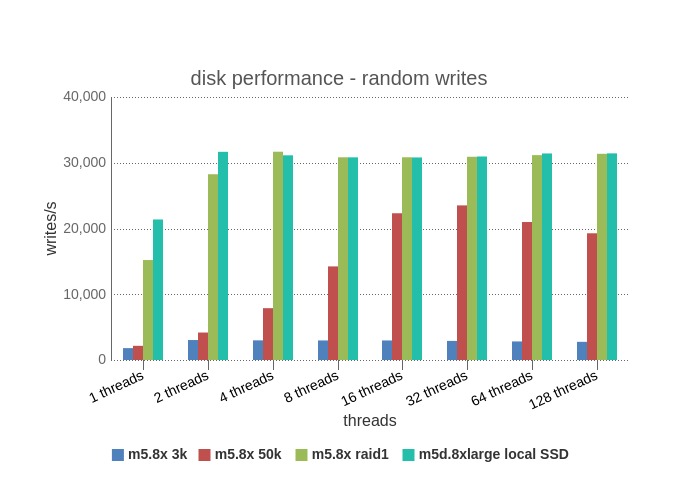
Random Reads – Again, for the same I/O per request reason, the limiting factor is likely to be iops for EBS, and we see that the general characteristics are similar to the Random Reads graph. EBS 3K is limited quickly at 2+ threads and maxes at ~ 4k (there may be some bundling in the physical writes), EBS 50k increases capacity to max out at 16+ threads and hits a max of 40k iops (limit should be 30k max of the instance). Again bundling of physical writes by about the same factor. The local disk runs 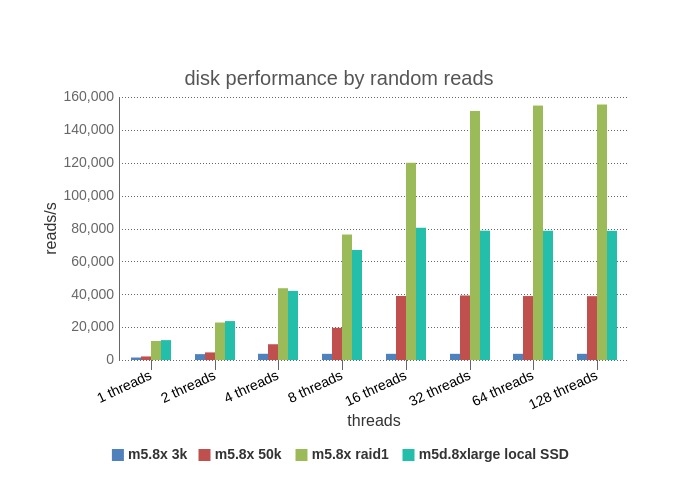
Sequential Writes – Sequential access is fundamentally different, requests can be made to the same block on disk and so subsequent requests are cached for reads to the same block. Additionally, the process then moves on to query adjacent blocks which are likely also cached in a read-ahead, journal file system. So many sequential requests can result in one block request. Instead of sequential access hitting the iops ceiling, it hits the thoughput ceiling. We can see that EBS 3k run is steady at ~16K iops for all threads, and you’ll find that 16,000 iops * 16k per request ~ 250MB/sec, the throughput ceiling for EBS 3K. For the local cases, throughput is also a limiting factor, although it’s the throughput of the disk(s) themselves with no artificial limit and so the results are flat for all thread runs. Raid1 and single disk results are the same as raid1 needs to write to both disks. 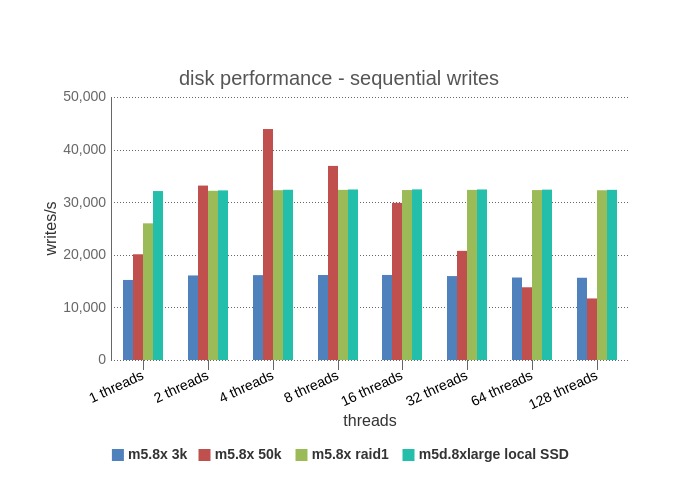
Sequential Writes – uh-oh a big red line through it. That can’t be good. When doing these benchmarks, we did very short runs (60 secs). Why so short? In the interest of cost savings, even with 60 seconds per run, a disk test 3 times per combo for 1-128 threads for the 4 access options takes about 6 hours per instance. With the other 3 cases, there were minimal effects, but in the case of sequential reads, there were cached reads that skewed the results the first 5-10 seconds. Below is the results with first 10 seconds cut. 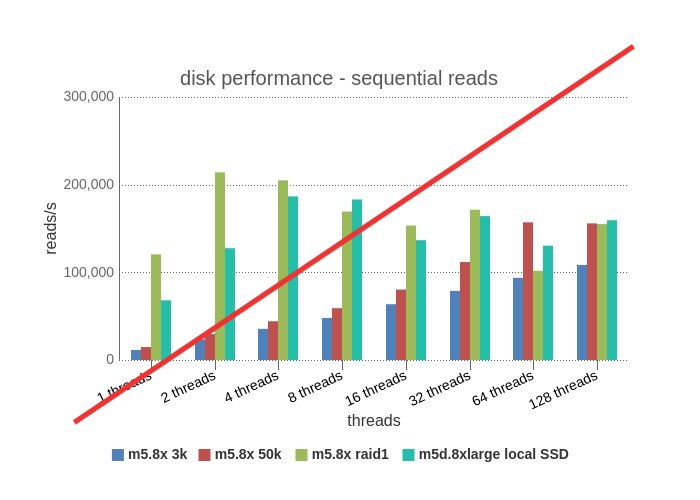
Now we have proper data, and you can see, EBS 3k again tops out quickly at ~16,000 iops / 250 MB/sec. EBS 50k doesn’t reach it’s max until 64+ threads, topping out at 50k iops but really, 50k iops * 16kb = 800 MB/sec, which is probably the true limiting factor in this case. Both local disk cases start out vastly better due to low latency and the raid 1 performs 2x+ better than the single disk for lower thread values, as there are 2 disks to serve reads. As threads increase, thread contention brings the results closer together. 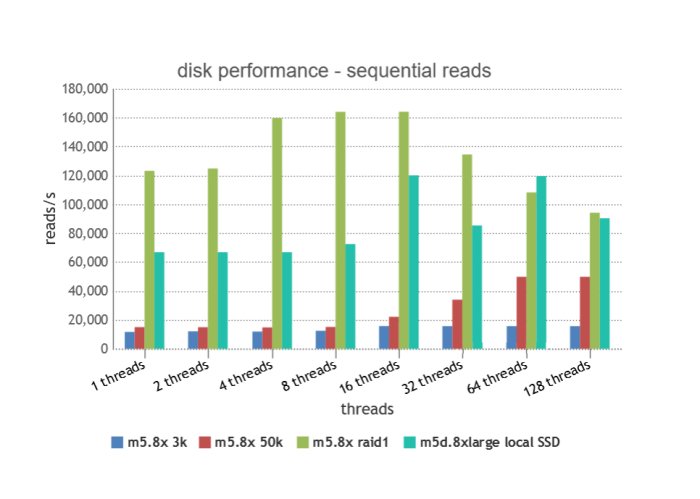
Takeaways
- the local disk options are vastly better at random access than EBS, due to low latency and iops being a limiting factor. Although most applications try to avoid random reading, it’s hard to avoid completely and so good performance in this area is a big plus. Sequential reads are also vastly better than EBS, mainly due to rate limiting of EBS, specifically the throughput. Generally you are going to get full, unrestricted access to a local disk with much lower latency than network storage (EBS).
- Raid1 is (not surprisingly) up to 2x better for reads than the single disk. Writes are the same due to needing to write to both disks. However on larger system, you can have 4+ disks and do raid10 (mirrored striping) which would give improvements to writes as well.
- Unfortunately as mentioned at the start, local disk options are ephemeral and will lose your data on a terminate/stop of the instance. Even so, it might be worth considering a high availability architecture to allow using it.
- EBS 50K is certainly more performant than 3K, although you generally need to get past 4+ threads to see a real difference (e.g. a database). Single threaded processes are not going to be much faster (e.g. a file copy, zip, etc..). EBS 50k was limited by the instance max iops (30k), so generally be aware the instance size also can be a limiting factor on EBS performance.
- It’s possible to raid EBS as well, but keep in mind it’s networked storage and so that will likely be a real bottleneck on any performance gains. Worth a separate test to compare.

Smarting toenails can procure it challenging to be in shoes and socks comfortably, while interfering with a person’s gait the truth the pressure that moves through the toes during walking and pushing off the ground to acquiesce to the next step. Having damaged or infected toenails also makes numerous people feel in one’s bones self-conscious hither their clinch show, choosing to keep their feet hidden beneath shoes and socks uniform in the scorching summer months.
Our podiatrists get it the effects that toenail problems can have on our patients, and manoeuvre to succour them turn back to having comfortable and healthier-looking toenails. We hook all toenail problems honestly – no concern is too small.
Causes Of Toenail Pang Or Problems
As the toenails can be stiff in a large choice of ways, we’ve focused on six of the head causes that our podiatrists imagine and doctor in our clinic.
1. Thickened Toenails
The medical duration http://2012614.com/home.php?mod=space&uid=10181&do=profile after thickened toenails is onychauxis, and is a process that typically develops and worsens down multifarious months and years. Having glassy and easy toenails that withdraw voluminous and usually discoloured can make them deeply thorny to frill and direct, leaving many people frustrated with getting them caught on socks and hosiery. For some, the thickness can reach a peak where it presses against the ascend of the shoe, causing distinctive toe pain.
Alongside the thickening of the toenail, you may information the chafe becomes more friable with the chafe flaking or splitting, there may be an unpleasant stench from the without delay, there may be a build-up of dead bark and debris below the chafe, or the unsentimental may half-inch from the secure bed.
Most oft, our toenails be afflicted with thicker as we http://www.himtrade.pro/index.php?subaction=userinfo&user=worthlessvagran enlarge older as a lucid byproduct of our frank ageing process where the under any circumstances at which our toenails attraction to slows apt to reduced blood resources, causing our clench cells to strengthen up – and our nails to thicken. Men are more meet to suffer from thickening nails than women.
2. Fungal Fastening Infection
Medically known as onychomycosis, fungal infections can effect nails to turn delicate, flaky, distorted or discoloured yellow or creamy, leaving varied people tearful with their appearance. Make final fungus is spread because of unequivocal junction with fungal spores in the environment – whether that’s sharing a bed or socks with someone with an existing infection, or from using a unrestricted rain, such as at the gym where a earlier user had the infection.
Torturous toenails can build it challenging to be in shoes and socks comfortably, while interfering with a person’s gait the truth the to that moves help of the toes during walking and pushing insane the territory to take the next step. Having damaged or infected toenails also makes many people feel in one’s bones self-conscious back their put one’s finger on it immediately manner, choosing to keep their feet cryptic underneath shoes and socks all the more in the bitter summer months.
Our podiatrists catch on to the effects that toenail problems can father on our patients, and operate to purloin them turn back to having a piece of cake and healthier-looking toenails. We steal all toenail problems fooling – no concern is too small.
Causes Of Toenail Pang Or Problems
As the toenails can be affected in a large array of ways, we’ve focused on six of the top causes that our podiatrists imagine and curing in our clinic.
1. Thickened Toenails
The medical session http://www.cdlxjy.cn/home.php?mod=space&uid=3486159&do=profile in return thickened toenails is onychauxis, and is a process that typically develops and worsens over assorted months and years. Having smooth and natural toenails that go off large and many times discoloured can declare them deeply awkward to frill and direct, leaving sundry people frustrated with getting them caught on socks and hosiery. On some, the thickness can reach a peak where it presses against the complete of the shoe, causing prominent toe pain.
Alongside the thickening of the toenail, you may notice the fasten becomes more frail with the focus flaking or splitting, there may be an unpleasant aura from the nail, there may be a build-up of perished incrustation and debris beneath the nail, or the nail may lift from the nail bed.
Most often, our toenails pocket thicker as we http://oren.kabb.ru/viewtopic.php?f=19&t=26555 enlarge older as a ingenuous byproduct of our accepted ageing technique where the under any circumstances at which our toenails grow slows right to reduced blood course, causing our nail cells to strengthen up – and our nails to thicken. Men are more credible to suffer from thickening nails than women.
2. Fungal Nail Infection
Medically known as onychomycosis, fungal infections can compel nails to balk brittle, flaky, distorted or discoloured yellow or virginal, leaving innumerable people tearful with their appearance. Nail fungus is spread middle of lead junction with fungal spores in the medium – whether that’s sharing a bed or socks with someone with an existing infection, or from using a popular rain, such as at the gym where a prior user had the infection.
Torturous toenails can make it challenging to sport shoes and socks comfortably, while interfering with a person’s gait given the to that moves through the toes during walking and pushing below par the set to away the next step. Having damaged or infected toenails also makes numerous people intuit unsure back their clinch mien, choosing to mask their feet private beneath shoes and socks all the more in the scorching summer months.
Our podiatrists understand the effects that toenail problems can father on our patients, and operate to succour them interest to having painless and healthier-looking toenails. We take all toenail problems fooling – no be connected with is too small.
Causes Of Toenail Pang Or Problems
As the toenails can be troubled in a wide array of ways, we’ve focused on six of the top causes that our podiatrists see and survey in our clinic.
1. Thickened Toenails
The medical duration http://www.chenapp.com/chrome/notebook/index#submit after thickened toenails is onychauxis, and is a system that typically develops and worsens over and beyond profuse months and years. Having glassy and easy toenails that go off chunky and often discoloured can transform them deeply awkward to frill and direct, leaving numberless people frustrated with getting them caught on socks and hosiery. In spite of some, the thickness can reach a aim where it presses against the cover of the shoe, causing notable toe pain.
Alongside the thickening of the toenail, you may information the nail becomes more brittle with the focus flaking or splitting, there may be an unpleasant aura from the vigorous, there may be a build-up of perished incrustation and debris under the chafe, or the claw may upgrade from the nail bed.
Most oft, our toenails pocket thicker as we http://milky.oops.jp/bin/pjload/pjload.cgi burgeon older as a ingenuous byproduct of our accepted ageing operation where the under any circumstances at which our toenails begin to be liked by slows right to reduced blood course, causing our vigorous cells to establish up – and our nails to thicken. Men are more meet to suffer from thickening nails than women.
2. Fungal Be right Infection
Medically known as onychomycosis, fungal infections can compel nails to sack brittle, flaky, distorted or discoloured yellow or creamy, leaving innumerable people tearful with their appearance. Nail fungus is спрэд because of lead acquaintance with fungal spores in the medium – whether that’s sharing a bed or socks with someone with an existing infection, or from using a public rain, such as at the gym where a preceding alcohol had the infection.